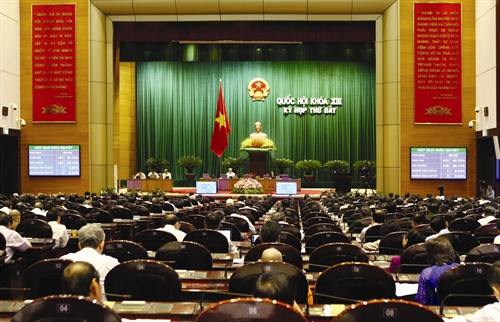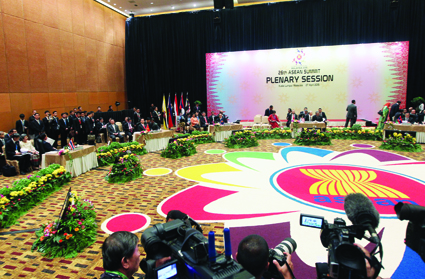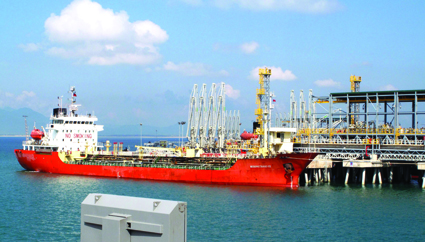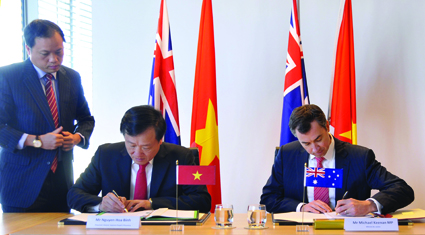Truong-Minh Vu[1] and Trang Pham[2]
China’s position paper published on December 7, 2014, is one of the rare documents in which Beijing officially expressed its opinions on the issues in the South China Sea as well as on the arbitration proceedings that the Philippines initiated at the Permanent Court of Arbitration in January 2013. It seems that the motivation was the December 15 deadline (which China has ignored) for its response to the Philippines’s claims before the Tribunal.
China’s views on its refusal to appear in the arbitral proceedings can be summarized in four inter-related main points. First, lying at the heart of the disputes between China and the Philippines is the territorial claims over sovereignty over the archipelagos in the area, rather than interpreting the United Nations Convention on the Law of the Sea (1982 UNCLOS). Therefore, in Beijing’s view it is beyond the scope of the jurisdiction of the Tribunal to entertain the case. Second, China stresses that the Philippines has to respect bilateral statements between them as well as the 2002 ASEAN-China Declaration on the Conduct of Parties in the South China Sea (DOC), in which they agreed to solve their maritime issues through negotiations alone. Third, even if the Philippines has the right to bring the case to the Tribunal, China is not bound by it as in 2006 it submitted a declaration to the United Nations exempting itself from compulsory arbitration and other dispute settlement procedures. And finally, the fact that China has never chosen the other options for arbitration provided by the 1982 UNCLOS leads to a violation in international law.
Since the case of Nicaragua and the US, the situation of non-appearance was virtually non-existing for more than 25 years, and then came the Arctic Sunrise case with Russia refusing to appear in the proceedings in 2013. In the same year, the world witnessed another case of default of appearance in the South China Sea. It is the case between the Philippines and China where the latter enthusiastically showed (and is showing) its interest in not appearing before the Court.
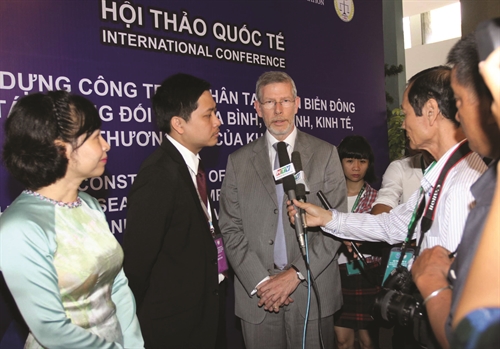 |
| Prof. Dr. Erik Franckx, an arbiter of the Hague Permanent Court of Arbitration, talks to journalists at an international conference in Ho Chi Minh City __Photo: Thanh Vu/VNA |
After a series of failed negotiations with China concerning the disputes in the South China Sea, the Philippines decided to employ the Arbitral Tribunal under Annex VII to the 1982 UNCLOS to challenge the claims of China. China refused to join the arbitration case and warned that it can damage the bilateral relations. Despites China’s rejection, the arbitration court is still carrying out the procedures. In response to the first procedural order by the Arbitration dated August 17, 2013 the Philippines submitted the Memorial on March 30, 2014. In its second procedural order, the tribunal issued a note fixing December 15, 2014, as the deadline for China to submit its counter-memorial.
Nong Hong, the head of the Institute for China-America Studies (ICAS), argued that after the case between the Philippines and China before the Arbitration under Annex VII to the 1982 UNCLOS, the complexity and nature of the disputes in the South China Sea remain and the arbitration case is just a political game of international law. Following that thought, another Chinese scholar suggested that no matter what the outcomes of the case would be, the Philippines would lose rather than win. Due to the power asymmetry between these two countries, the Philippines is likely to launch a risky game which may lead it to several severe disadvantages.
Those arguments reveal the well-recognized drawbacks of the 1982 UNCLOS as well as the inconvenient truth of international politics concerning the role of great powers and their impacts on smaller states. Nonetheless, their views on the South China Sea case solely reflect one aspect of the issues. Indeed, the disputes in the South China Sea cannot be settled entirely by the Arbitration. However, after the case, the perception of the international community towards the disputes will be changed, which may make China, not the Philippines, a sufferer (a loser).
There is an assumption that the disputes in the South China Sea cannot be settled unless the issues concerning sovereignty over the islands and maritime delimitation are solved; however, it is not quite correct. In fact, the disputes there can be divided into groups entailing different legal claims, which can be settled separately. The most highly controversial disputes in South China Sea concern (are concerning) maritime features in the region. They are the disputes over sovereignty over those features and those concerning their legal status. While the former fall out of the scope of compulsory settlement procedure in Part XV of the 1982 UNCLOS, the latter can legally be brought to any appropriate court/tribunal by just one of the parties to the dispute.
The second dispute is about of maritime delimitation. China is the only state in the South China Sea excluding this matter from any judicial jurisdiction. The last disputes are related to the well-protected subjects of the Law of the Sea, which are maritime environment protection and freedom of navigation. And interestingly enough, there are the typical disputes concerning the legality of the so-called nine-dash-line map and “historic rights”, which can only be found in the claims and announcement of China.
The arbitration case between the Philippines and China cannot settle all of them as the Philippines does not ask the Court to. The Arbitral Tribunal, if passing the jurisdiction test, will address the issues of the legal basis of China’s nine-dash-line map and “historic rights” in the South China Sea under international law, the legal status of maritime features and whether activities of China damaged the marine environment in the region. Those issues make up essential parts of the South China Sea disputes since the vagueness lying within them arguably increases the tension in the disputed area.
First of all, the interpretation of Article 121 explaining legal definitions of “islands” and “rocks” is the prime example for such ambiguity. According to Professor Erik Franckx from the Department of International and European Law at Vrije Universiteit Brussel, there has always been a difficulty in practice to obtain a uniform explanation for this article as the used language enables each party to have their own understanding. The International Court of Justice (ICJ) and the International Tribunal for the Law of the Sea (ITLOS) in their previous law of the sea cases also found their way to not directly comment on this issue. The Black Sea case and the case between Bangladesh and Myanmar respectively are the recent instances. And, the South China Sea arbitration case is the first time a state party has directly asked an international tribunal to decide on such problem. The decision of the Arbitral Tribunal on the case will not only unfold the complexity of the current disputes, which manifestly reduces the tension in the region, but also contribute to the development of international law as well. Therefore, it is insensible to underestimate the legal importance of the Philippines. v. China case.
Philippines’s arbitration case against China in the International Court sets a good precedent for other ASEAN claimants in seeking solutions to the prolonged South China Sea disputes. The first benefit of the case is that it will force (that the case would bring about is that both) China and the Philippines to explain their interpretation and application of the 1982 UNCLOS. Although China refused to take part in the tribunal as said above, it still has to clarify its claim of the U-shaped line. Understanding China’s interpretation would give another claimant a big advantage in the legal struggle against Beijing’s baseless arguments. In addition, not only China but the Philippines also has to make its position clear concerning the interpretation and application of Article 121, Paragraph 3 of the 1982 UNCLOS on the regime of islands to disputed features in the Spratly islands.
Secondly, if the Tribunal decides that the nine-dash-line map of China has no legal basis or whatsoever under the Law of the Sea, Beijing will lose one of its arguments for its highly controversial activities; inter alia, artificial island building, in the South China Sea lawfully and politically. Following the same thought, if the Tribunal also decides that the maritime features in the claims of the Philippines cannot generate either 200 nautical miles of sovereignty rights or continental shelf, the disputed areas in the South China Sea will be significantly reduced. It will lead to an easier way to solve the maritime delimitation problem in the region.
Thirdly, although China is not obligated to appear before the Arbitral Tribunal, it cannot escape the fact that it is still a party to the case. Hence, the award of the tribunal remains fully and ultimately binding on it. Indeed, China’s signing and ratification of the 1982 UNCLOS implies its granting consent “in-advance” to the judicial exercise by the court or tribunal concerned. In other words, China has accepted the fact that another state could unilaterally bring a dispute against it under the compulsory mechanism provided in Part XV of the 1982 UNCLOS. Hence, the ground for China to challenge the jurisdiction of the court or tribunal based on the principle of state consent cannot be justified.
What are the consequences of China’s approach to the South China Sea arbitration case? Maybe not 2015 and 2016. The real impacts on China can be felt (will have looms) in the next five or ten years in the future, when it will be time for China to settle all of its disputes with its neighbors. China’s interaction with its 17 neighbor countries has been increasing not only in depth but also in scope. Disputes of all kinds may happen at any time. More importantly, it is insensible for China to underestimate international law because legal mechanism may be the safest and most economical tool for China to protect its lawful rights and interests in the global arena. The non-appearance of China in this case may lead to (trigger) bigger negative impacts not only on the South China Sea but also other areas. For example, there may be a “non-appearance” attitude of Japan in the case in the East China Sea initiated by China.
It should be taken into account that after the South China Sea arbitration case, the disputes concerning sovereignty and maritime delimitation in the area will remain unsettled. Furthermore, China may not comply with the award of the Arbitration and may have its own interpretation of the rules of international law. Chinese political elites might simply decide that it did not want to be committed to exiting international law when China becomes more powerful. With the “rising power” subtitle in its nametag, China is seemingly granting itself the right to change established laws, which may upset its peaceful rise (way of peacefully rising). However, pursuing such policy may bring China reputation risks and financial problems. Member states of the Asian Infrastructure Investment Bank (AIIB) participating countries on One Belt, One Road initiated and endorsed by China may be skeptical about the development prospects of those institutions since China, despite being a party to international agreements setting up those organizations, is always attempting to find a way out of any compulsory dispute settlement mechanism. It means that laws and institutions in Chinese eyes are a tool to obtain power, not an instrument to peacefully balance conflict of interests.
More importantly, the way in which rising powers like China interact with international institutions and laws produces and expressees imaginaries. They can also turn into a referent object or an arena for the collective rearticulating of underlying values, visions and hopes. In other words, this approach is close to the understanding that the new normative order in East Asia has been constructed. The underlying process is not one-way. Setting the new rule of the game does not rely on the fact that every single state in the world carries out the same action, but the widespread acceptance and the consistency of such practice are the key. China does not single-handedly attempt to limit freedom of navigation (put more limit to the navigational rights of vessels on the sea). It is much more complicated than the portrayal of rising states buying “into the hegemon’s vision of international order and accept it as their own”.
The new regional order has been emerging as a result of regional power shift in the Asia-Pacific, though which Beijing policymakers think that their country thanks its thousand years of wisdom and experience in dealing with its neighbors could manage an asymmetric relationship with lesser states in the region. But on the South China Sea disputes, its actual effects tend to tilt towards to opposite direction. As a rising power, China has become a “big friend of choice” of the international community with a queer mix of dependence and suspicions. However, that choice became more and more unsuitable. The existing power gap between the US and China means that any direct, or indirect, confrontation with the US in the South China Sea will wreak tremendous havoc on the Chinese economy amidst its turning point.
China’s military might, economic power, and cultural sway might be enough to make the country a great power. Yet these resources are not sufficient to help Beijing achieve its political and strategic goals through coercion or going it alone. In military terms, China is still behind America. Economically, its power is reliant on other states, especially with neighboring countries. China’s paradox, therefore, is that while its rising capabilities may seem to afford it the opportunity to pursue alternatives to the existing rules, its reputation and credibility are insufficient to establish new rules altogether which can be widely accepted by its Asian neighbors. If Beijing continues to follow the current approaches, China’s interests in the short term can still be achieved, but it is sure that the future strategic environment will develop in a trend that is totally disadvantageous for this power in Asia. The South China Sea arbitration case, therefore, has proven to be a typical example of how international law shaping the choices of a rising power.
The article was partly published by The Diplomat.-
